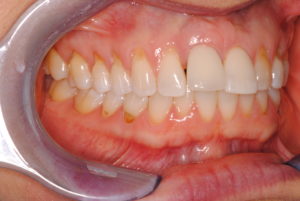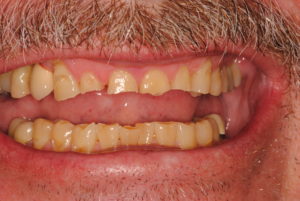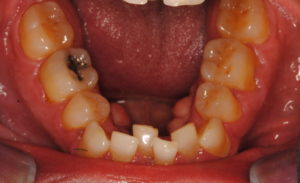Prevent bacterial problems
Preventing bacteria or cavities is highly beneficial for both your health and your wallet.
Preventing cavities
For instance, we know that 95% of back teeth decay if the dentist does not seal the grooves. We can use a thin, protective coat, known as sealant, that stops the cavity-causing bacteria from forming holes in your teeth. Without a sealant, a tooth can develop a cavity, requiring a filling in that tooth, or in some cases the tooth can be so decayed that it requires a crown to cover the tooth. If you can avoid getting to that point by getting the sealants upfront, you end up paying a fraction of the cost.
| Average Cost for Sealant | Average Cost for Filling a Tooth | Average Cost for a Crown |
| $50-85 per tooth* | $200-450 per tooth* | $1200-1800 per tooth* |
Preventing gum disease
 Similar to how you can preventively treat bacteria that causes cavities, there are also ways to prevent bacteria that causes gum disease. When you’re seeing your dentist or hygienist regularly, they’re able to measure the gum pockets around your mouth in order to catch gum inflammation early.
Similar to how you can preventively treat bacteria that causes cavities, there are also ways to prevent bacteria that causes gum disease. When you’re seeing your dentist or hygienist regularly, they’re able to measure the gum pockets around your mouth in order to catch gum inflammation early.
The main problem with gum inflammation is it leads to gum disease. Gum disease causes bone loss, and bone loss is ultimately what causes tooth loss. If you can catch inflammation early before it causes any bone loss, then you can prevent yourself from having to lose teeth and then having to pay for expensive replacements for a tooth, like a bridge or an implant.
| Average Cost for a Teeth Cleaning | Average Cost for Root Planing and Scaling | Average Cost for Bridge | Average Cost for Implant |
| Gum inflammation can be diagnosed | Treatment for Gum Disease | To replace lost tooth | To replace lost tooth |
| $135-160 per appointment* | $260-325 per quadrant*+ | $1800-3375 per three unit bridge* | $2000-3000 per tooth* |
In addition to the money savings of preventing cavities or gum disease through regular maintenance and early treatment, you can also avoid unnecessary pain or discomfort caused by decay and disease.
Preventing loose, chipped and worn teeth
It is a common misconception that changes in our teeth as we get older, such as wear, cracks, chips, breaks, or even tooth loss, is normal and inevitable. All of these things can be caused by instability in your chewing system.
One of The Dawson Academy’s philosophies that is taught to all of our dentists is that we should perform a complete, thorough exam on every patient. From this complete exam, we can see things on the teeth that are signs of instability, such as:
- Teeth with the enamel wearing off
- Migration or movement of the tooth
- Looseness and mobility in the teeth
- Broken and chipped teeth
- Gum-line recession
Those are all signs that the bite relationship is not stable, meaning the teeth, jaw muscles and joints are not all in harmony. If we can catch these signs early, then we have the opportunity to figure out what’s causing it. After it’s been diagnosed, then we can find a way to at least slow, if not stop, those problems from developing further.
By catching problems early, you can avoid a lot of expensive procedures. For example, if gum-line recession is caught early and we can get rid of the additional forces that are causing the recession, you can avoid having to receive gum grafts. Another possibility is if we see the teeth are wearing down and we can figure out what’s causing the wear, then we can correct the bite and prevent you from having to keep going back to your dentist to get the same teeth repaired over and over again.
The treatment options can vary, depending on what the diagnosis is, but many of these types of instability may require us to reshape the teeth. If we are seeing any type of migration or mobility, we may need to reposition the teeth with orthodontics, or restore the teeth to get the bite in harmony with the muscles and joints.
What if I ignore dental problems?
 All these problems are progressive and one of your options is always not to do treatment, but the disadvantage of not doing treatment early is that these signs will progress. If your teeth are decaying, wearing, migrating or are over-crowded, they will gradually get worse.
All these problems are progressive and one of your options is always not to do treatment, but the disadvantage of not doing treatment early is that these signs will progress. If your teeth are decaying, wearing, migrating or are over-crowded, they will gradually get worse.
When you see yourself every day, it happens so gradually that you might not notice the changes. It’s not like you wake up and your teeth are two millimeters shorter overnight. It’s like with aging: we look at ourselves in the mirror, and we don’t notice the progression of the wrinkles or the gray hairs. It isn’t until you have consulted with an expert, like your dentist, do we sometimes become aware of these problems.
*Prices may vary depending on materials, time required to create and place material, and geographic location
+The mouth is divided into four sections called quadrants. Quadrant dentistry means that all the dental treatment required in a quadrant is carried out in a single appointment.


